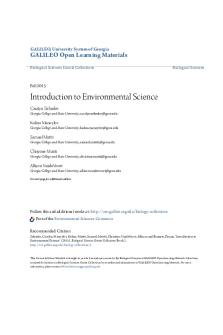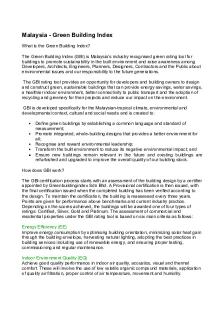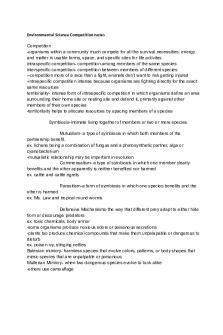Practical, Environmental Science Review Questions PDF

| Title | Practical, Environmental Science Review Questions |
|---|---|
| Author | Melissa Yang |
| Course | Environmental Science |
| Institution | The Pennsylvania State University |
| Pages | 4 |
| File Size | 172.5 KB |
| File Type | |
| Total Downloads | 3 |
| Total Views | 172 |
Summary
Download Practical, Environmental Science Review Questions PDF
Description
Environmental Science Chapter 1 to 4 Questions Review 1. The term environment includes which of the following? A. Living things, such as animals and plants B. Nonliving things, such as rivers and soil C. Oceans, rivers, streams D. Buildings and cities E. All of the above are included in this term 2. What is the definition of sustainable development? A. Using resources to benefit future generations, even if it means lower current availability B. Letting future generations figure out how to solve their own problems C. Letting each country decide what is tis best interest D. Using resources to satisfy current needs without compromising availability E. Increasing economic output even if ti harms the environment 3. Which of the following statement is false about negative feedback loops? A. Input and output neutralize each other B. The system is stabilized C. It is mostly seen in systems altered by humans D. The output moving in one direction acts as input that moves the system in the other direction E. All of these statements are true 4. According to this graph, which terrestrial ecosystem has the most biomass? A. Temperate grassland B. Boreal forest C. Savannah D. Tropical rain forest E. Algal beds
5. Who should be responsible for reducing nitrogen pollution and eutrophication of coastal waters? A. Fisherman, because they reap the benefits of fishing B. Farmers, because they are causing much of the problem C. Taxpayers, because they are getting both fish and food D. The federal government, because its job is to protect American citizens and the environment E. Nobody, because the oceans can cleanse themselves 6. Which of the following is false about the process of natural selection? A. It can direct and influence evolution B. Traits that enhance survival and reproduction are passed on to future generations C. It helps elaborate and diversify traits D. It can lead to the formation of new species E. All of these statements are correct about natural selection 7. Allopatric speciation could occur in all of the following expect which one? A. One population of sparrows mates in May, and another population mates in June B. A population of cedar trees is separated by a new mountain range formed by an earthquake C. A population of meadow flowers is divided into two when a glacier melts D. A valley floods and forms a permanent river, which divides a population of deer E. All of these would result in allopatric speciation
8. What does this graph show? A. A logistic growth curve B. An exponential growth curve C. An unusual type of population growth D. That only yeast cells have this type of growth curve E. None of the above
9. Competition is a form of species interaction where A. Both species are harmed B. One species benefits, but the others is harmed C. Both species benefit D. One species invites another to enter a particular area E. Neither species is partcualry affected 10.Which statement is flase about trophic levels? A. autotrophs(plants) occupy the first trophic level B. detritivores consume waste products or dead bodies C. biomass and energy increase going up the food chain D. there are fewer predator speices than prey species in an area E. food webs leave out many speices interactions 11.secondary succession would take place on which of the following? A. The slopes of a newly formed volcanic island B. Wetlands in Taxes, following Hurricane Rita C. A receding glacier D. Vegetation grwoing in a newly exposed lake bed E. Secondary succession would not occur in any of these areas
12.What does this figure illustrate? A. A predator – prey cycle B. Competitive exclusion C. Resource partitioning D. Succession E. Mutualism...
Similar Free PDFs

Environmental Science Midterm Review
- 17 Pages

Environmental Science Review Sheet
- 19 Pages

Environmental Science Questions
- 52 Pages

Environmental Science
- 16 Pages

Environmental Science Module 1
- 4 Pages

Environmental Science and Engineering
- 109 Pages

Environmental Science Lecture notes
- 25 Pages

Environmental Science English Only
- 10 Pages
Popular Institutions
- Tinajero National High School - Annex
- Politeknik Caltex Riau
- Yokohama City University
- SGT University
- University of Al-Qadisiyah
- Divine Word College of Vigan
- Techniek College Rotterdam
- Universidade de Santiago
- Universiti Teknologi MARA Cawangan Johor Kampus Pasir Gudang
- Poltekkes Kemenkes Yogyakarta
- Baguio City National High School
- Colegio san marcos
- preparatoria uno
- Centro de Bachillerato Tecnológico Industrial y de Servicios No. 107
- Dalian Maritime University
- Quang Trung Secondary School
- Colegio Tecnológico en Informática
- Corporación Regional de Educación Superior
- Grupo CEDVA
- Dar Al Uloom University
- Centro de Estudios Preuniversitarios de la Universidad Nacional de Ingeniería
- 上智大学
- Aakash International School, Nuna Majara
- San Felipe Neri Catholic School
- Kang Chiao International School - New Taipei City
- Misamis Occidental National High School
- Institución Educativa Escuela Normal Juan Ladrilleros
- Kolehiyo ng Pantukan
- Batanes State College
- Instituto Continental
- Sekolah Menengah Kejuruan Kesehatan Kaltara (Tarakan)
- Colegio de La Inmaculada Concepcion - Cebu







